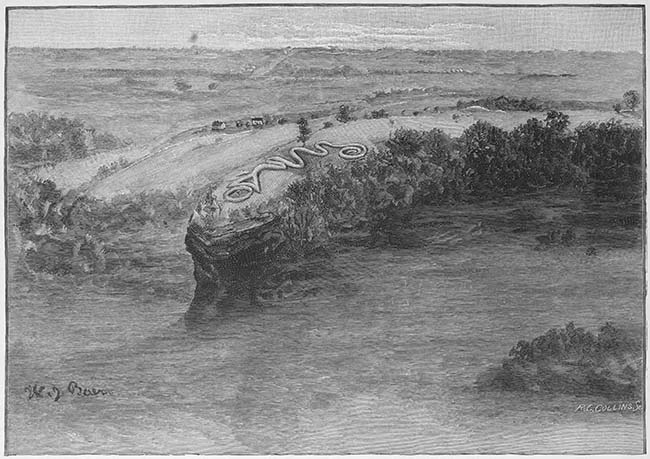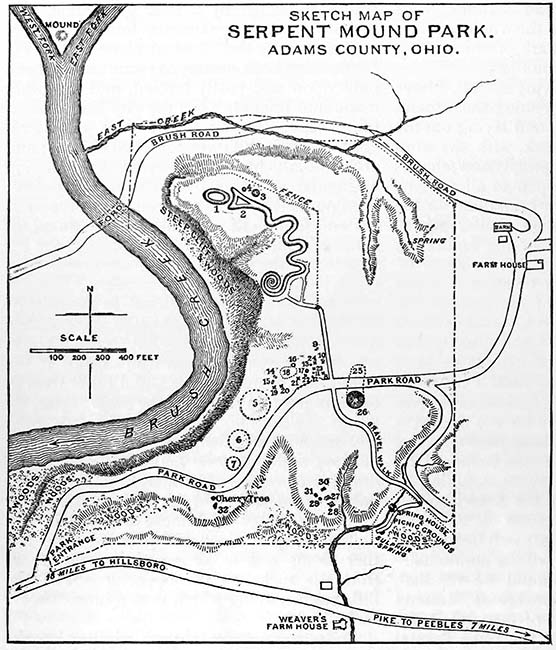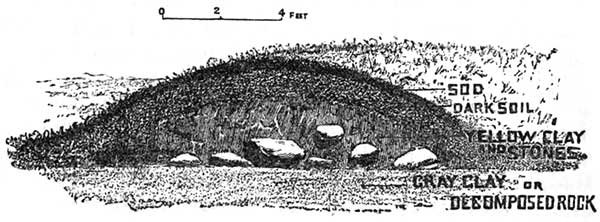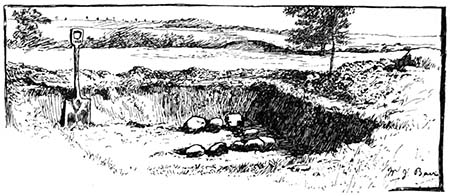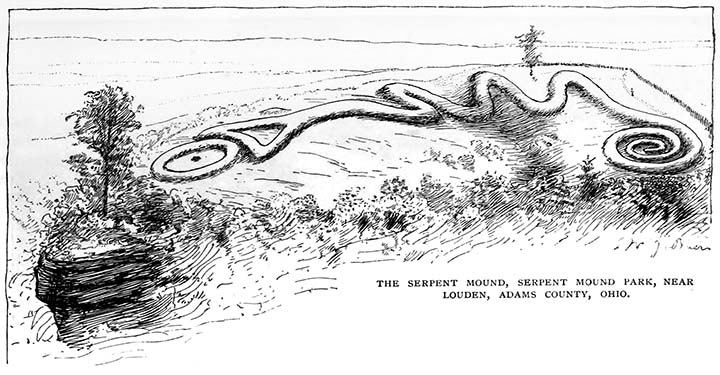
The Serpent Mound of Ohio.1
November 1889 - April 1890
Volume 39
F. W. Putnam
In September, 1883, in company with four fellow-archaeologists, I started from Hillsborough, in Highland County, Ohio, on an excursion to several ancient earthworks which we had long wished to see. Our plans were so arranged as to take us first of all to the Serpent Mound, thence to Fort Hill, and down Paint Creek to the Scioto, stopping from day to day to visit the most interesting of the many ancient works along the route.
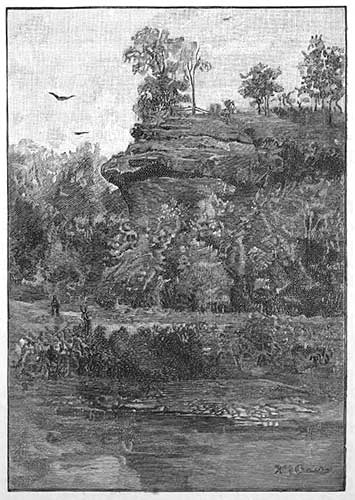 |
| The Serpent Cliff as seen from Brush Creek. |
Reclining on one of the huge folds of this gigantic serpent, as the last rays of the sun, glancing from the distant hilltops, cast their long shadows over the valley, I mused on the probabilities of the past; and there seemed to come to me a picture as of a distant time, of a people with strange customs, and with it came the demand for an interpretation of this mystery. The unknown must become known! This thought took complete possession of me, and on that same evening arrangements were made with Mr. Lovett, the owner of the land, to have the place cleared of underbrush that we might see the great work in its entirety. By noon of the following day the clearing was roughly made, and the view thus obtained of the serpent and the egg as the oval work in front of its jaws has been called led to a still stronger desire to know more, and a resolve to do all in my power to preserve this singular structure, which seemed so strangely transplanted from the mythology of the East.
When Squier and Davis, after their survey in 1846, gave to the world the first account of this earthwork, it was covered with a thick forest, from which many a noble tree has been cut, as indicated by stumps still standing at the time of our visit. Thirteen or fourteen years after their visit a tornado swept its path directly along the serpent hill, and with the exception of a few saplings the forest was laid low. This led to clearing the land, and to the cultivation for a few years of the portion occupied by the serpent. Nature soon covered the scars with a protecting sod, which was followed by a growth of sumach, redbud, and briers.
On my return to the East I took every opportunity of urging the importance of preserving the Serpent Mound, as well as other ancient monuments. In 1885 I again visited the serpent, and finding that its destruction was inevitable unless immediate measures were taken for its preservation, I secured a contract that it should remain intact for a year, and agreed upon a price for its purchase. Returning home I urged anew the importance of its preservation. Yet, although an interest was awakened in the object, I fear it might have come to naught if Miss Alice C. Fletcher, meeting in Newport a few Boston ladies, had not taken the opportunity to appeal to them for assistance in the work which she knew I had so much at heart, and which was, at the same time, so thoroughly in accordance with her own views. Her earnest presentation of the subject had the desired effect. In the winter of 1886 several of Boston's noble and earnest women issued a private circular which had the indorsement of Mr. Francis Parkman and Mr. Martin Brimmer of the Corporation of Harvard University. Subscriptions were solicited to purchase the Serpent Mound, which was to be given in trust to the Peabody Museum for perpetual preservation, and also to enable me to carry on such explorations of the work and its surroundings as might throw light on its origin and purpose. This appeal was cordially met, and in June, 1886, I was provided with nearly $6000 with which to buy such land as seemed to be required for the purpose in view, and to take steps for the preservation of the serpent, while at the same time I made such explorations as seemed desirable. The trustees of the Museum, of whom the Hon. Robert C. Winthrop has been chairman since Mr. Peabody founded the Museum, in connection with Harvard University, in 1866, accepted this additional trust, and about sixty acres of land were at once purchased in the name of the trustees. Soon after, several acres of land along the new pike leading from Hillsborough to Peebles, the nearest railroad stations, were added to the purchase, and the whole was laid out as the Serpent Mound Park, of which Brush Creek forms the western boundary.
Here for three seasons, living in tents, I have carried on the work of protecting the serpent, exploring its surroundings, and laying out the grounds. This beautiful park, with the wonderful stories it tells of the past, is now, thanks to the women of Boston, open to all visitors. In appreciation of what has been done for the State, and also to encourage similar efforts, the park, by a special act of the legislature of Ohio, suggested by Prof. M. C. Reed of Hudson, is exempted from taxation and put under special protection of the laws of the State. Thus the first law for the protection of archaeologic monuments in our country has been brought about, and it cannot be long before similar laws will be passed by other States.2 Congress has lately had under favorable consideration a measure for the preservation of several archaeologic monuments on the public lands. This petition was prepared by Miss Fletcher and Mrs. Stevenson, acting as a committee appointed by the American Association for the Advancement of Science.3 The grand work is thus at last well begun, and we can but believe that it will be continued.
In this connection it should be recalled, with all honor to the pioneers at Marietta acting under the direction of General Rufus Putnam, that in laying out the town several portions of the ancient works were carefully preserved. These efforts, however, were not wholly respected by a later generation, and the two great embankments, forming an avenue, named by the classical pioneers the Via Sacra, have been destroyed one having been built upon and partly leveled, and the other made into brick! Thus the city lost a beautiful avenue leading to the river, deeply regretted now by all its enlightened citizens; and archaeologists have been deprived of studying a singular structure over which many have been puzzled as to its purpose. That the present and future citizens will properly guard, as a sacred trust from the old pioneers, the remaining works in the public squares and cemetery, is our most earnest petition.4
As will be seen by reference to the map of the Serpent Mound Park, a winding road leads from the pike up the steep hill to the plateau, which it crosses, and then winds down to the little wood of maples, oaks, and other trees in the southeastern corner of the park. Here, on the grassy hillside, under the spreading oaks and maples, is a delightful resort for picnic parties; and here one may find a refreshing draught of clear cold water from the spring bubbling out of the old devonian rocks. Over the spring a substantial house of stone has been built to keep it clean and pure. A little farther along is a sulphur spring, which flows from the rocks on the opposite side of the little ravine, along which runs a brook over a rocky bed.5
Following a graveled path winding up the hill from the picnic grove to the plateau, the first point of archaeological interest is reached. This is a conical mound nine feet high and seventy feet in diameter (26). Northwest of this, and not far from the serpent, is an old burial place which was afterwards the site of a village (8, 19), as shown by the ash beds, the many implements in various stages of manufacture, the many thousand chips of flint and other stones foreign to the locality, and the many potsherds and other objects scattered throughout the dark soil. A small mound (17), about a foot high, west of the path leading from the road to the serpent, and a few stones (10) nearer the path, mark the position of the cemetery, and all about there skeletons have been found in the dark soil or in the clay below it.
On the south side of the park road, on one of the projecting points of the plateau, now marked by several piles of stones (27-31) which were taken from around the graves in the clay below the soil, were graves of the first period of occupation. On the knoll west of this, over which a wild cherry tree now casts its shade, is a low oblong mound (32), a monument over four ancient graves. From this knoll, looking towards the setting sun, there is a grand view of the valley and the hills beyond; and standing on this spot one can readily imagine why it may have been chosen as the burial-place of the honored among a people whose sacred temple was near by.
North of this knoll, on the declivity from the plateau to the cliff, are three circular pits, varying in size; and much of the clay used in building the effigy of the serpent was probably taken from these places.
Following the ridge of the hill northerly to the overhanging rocks, one is forced again to pause and admire the scene before him the beautiful hill-girt valley with its acres of waving corn; the silvery line of the river with giant sycamores and graceful elms along its banks; and the vistas opening here and there, where the broader and deeper portions of the river are bordered with dark-green undergrowth, brightened by gleams of rich color.
Turning from this view, and ascending the little knoll behind the ledge, eighty feet from the edge of the cliff is the western end of the oval figure (1) in front of the serpent's jaws. This oval is one hundred and twenty feet long and sixty feet in greatest width, measured from the outer edge of the bank, which is about four feet high and eighteen feet across. Near the center of the inclosed area is a small mound of stones, which was formerly much larger, since it was thrown down over fifty years ago by digging under it in search of supposed hidden treasure, the popular belief which has caused the destruction of many an ancient cairn. Many of the stones show signs of fire, and under the cliff are similar burnt stones which were probably taken from the mound years ago; for I have been informed by an old gentleman, who remembered the stone mound as it was in his boyhood, that many stones taken from the mound were thrown over the cliff.
This portion of the hill was either leveled off to the clay before the oval work was made, or there was no black soil upon the hill at that time, as none was used in the construction of the embankment, nor left below it. The same is true of the serpent itself. Careful examination of several sections made through the oval and the serpent, as well as laying bare the edge along both sides of the embankments throughout, have shown that both parts of this earthwork were first outlined upon a smooth surface along the ridge of the hill. In some places, particularly at the western end of the oval, and where the serpent approached the steeper portions of the hill, the base was made with stones, as if to prevent its being washed away by heavy rains. In other places clay, often mixed with ashes, was used in making these outlines; and it is evident that the whole structure was most carefully planned, and thoroughly built of lasting material.
The geological formation of the hill shows first the ledge rock, upon which rests the decayed grayish rock forming the so-called marl of the region, the upper portion of which has by decomposition become a grayish clay. Over this lies the yellow clay of the region, filling in all irregularities, and varying in thickness from one to six feet. Upon this rests the dark soil of recent formation, from five inches to nearly two feet in thickness in different parts of the park. It is necessary to have this formation constantly in mind, as we must, to a certain extent, rely upon it in determining the antiquity of the works and burial-places.
Upon removing the sod within the oval the dark soil in the central portion was found to be nearly a foot in depth, where it must have formed after the oval work was built. How many centuries are required for the formation of a foot of vegetable mold we do not know; but here, on the hard gray clay forming the floor of the oval, was about the same depth of soil as on the level ground near the tail of the serpent, where it has been forming ever since vegetation began to grow upon the spot. The same results were obtained on removing the soil from the triangular space between the serpent's jaws; and that there was about the same amount of soil on the embankments is shown by the fact that the several plowings had not disturbed the underlying clay of which the embankments were constructed. The accompanying section through the western end of the oval illustrates this point.
Nine feet from the eastern end of the oval, and partly inclosing it, is a crescent-shaped bank, seventeen feet wide. From the extremities of this crescent, which are 75 feet apart, begin the jaws of the serpent, formed by banks 17 feet wide and 61 and 56 feet, respectively, in length, measured on the inside from the point of union with the crescent to their point of meeting, 47 feet from the convex or eastern edge of the crescent. We must here notice that the open jaws are shown as if the serpent's head was turned upon its right side, and the crescent embankment seems to have been designed to express this by uniting the open jaws across the mouth, indicated by the triangular space. This design was also carried out by making the northern or upper jaw the longer of the two. The head of the serpent across the point of union of the jaws is thirty feet wide and five feet high. From this point the neck extends eastward more than one hundred feet, with a slight curve to the north. Then begins what may be called the body of the serpent, making a graceful curve to the south, then winding to the east and north, then again to the south, and westward down the declivity of the central portion of the hill, where another graceful convolution is made up the opposite ascent to nearly the same level as the head; here it folds round in another full convolution, and the tail follows with a long stretch to the southwest, terminating in a triple coil.
The end of the tail points across the deep gully in the hillside to the western end of the oval, which is 496 feet distant in an air-line, but 1348 feet if measured from the western end of the oval to the neck of the serpent, and then along the dorsal ridge to the tip of the tail, thus following all the curves. Measured from the tip of the upper jaw to the end of the tail, the serpent itself is 1254 feet in length. The average width of the body of the serpent is about twenty feet, and its height along the head and body is from four to five feet. From the beginning of the tail it gradually decreases in width and height until it terminates in a bank about a foot high and nearly two feet wide.
The graceful curves throughout the whole length of this singular effigy give it a strange, lifelike appearance; as if a huge serpent, slowly uncoiling itself and creeping silently and stealthily along the crest of the hill, was about to seize the oval within its extended jaws. Late in the afternoon, when the lights and shades are brought out in strong relief, the effect is indeed strange and weird; and this effect is heightened still more when the full moon lights up the scene, and the stillness is broken only by the "whoo-whoo, hoo-hoo" of the unseen bird of night.
That such a work, so carefully designed, and constructed under such difficulties along this narrow ridge terminating in the high rough cliff, was planned and built under some powerful influence, we can but believe. And what other than a religious motive can be conceived? Have we not here the evidence of the former existence of that ancient faith, which, rising probably in the East, ages before historic time, held millions of people under its terrible sway; and, spreading over Asia, Africa, and Europe, has not yet been wholly supplanted, in India and Africa, by later faiths?6
That the serpent was prominent in the religious faiths of the Americans is beyond question, and that, to a certain extent, in combination with phallic and solar worship, it extended from Central America to Peru and Mexico, cannot be doubted, whatever its origin. Its existence in Yucatan is shown, as in Cambodia, by sculptures on the ruined buildings which can only be properly designated as temples. We know from history and art that this form of worship existed in Mexico down to the time of the Spanish invasion and conquest, and that it still survives in the rites of the Zunis and Moquis, and probably other of the Pueblo tribes.
To this southwestern region, with its many Asiatic features of art and faith, we are constantly forced by our investigations as we look for the source of the builders of the older works of the Ohio Valley. With these considerations in mind, and with the knowledge that structures similar to this in Ohio existed in the Old World,7 where the serpent and other early faiths had their greatest development, will it be forcing the facts to argue unless all religious symbolism is merely coincident, vague, and meaningless, which seems an absurd position to hold that in the oval embankment, with its central pile of burnt stones, in combination with the serpent, we have the three symbols everywhere regarded in the Old World as emblems of those primitive faiths? Here we find the linga-in-yoni of India, or the reciprocal principles of nature guarded by the serpent; or life, power, knowledge, and eternity. Moreover, its position, east and west, indicates the nourishing source of fertility the great sun-god whose first rays fall upon the altar of stones in the center of the oval. So that here we have associated the several symbols which in Asia would be accepted without question as showing the place to be a phallo-solar shrine combined with the serpent faith. Its very position8 on the high cliff terminating in the rough overhanging rocks, washed by the spring torrents, and near the three forks of the river,9 is to be considered when comparisons are made. This combination of natural features probably could not be found again in any part of the great route along which the people must have journeyed from the Mexican Gulf. Is this all to be taken as mere coincidence in the development of a faith in America and in the Old World? There seems to be too much here to admit of such a theory; and when other facts, in other lines, point in the same direction, it is playing false with our reason to be too skeptical. Agreements, nay, identities, would then mean nothing in science, and comparative studies would be useless. Fergusson, in his "Tree and Serpent Worship," mentions the existence of serpent worship on some of the Pacific islands, and refers to its possible transmission across the Pacific to America, and says if it is proved "that this worship is indigenous in the New World, we are thrown back on the doctrine that human nature is alike everywhere, and that man in like circumstances and with a like degree of civilization does always the same things, and elaborates the same beliefs. It may be so, but I confess it appears to me that at present the evidence preponderates the other way" (p. 39). When this careful author thus expressed his views, he was not acquainted with the details now pointed out in the combinations of the Ohio serpent shrine.
In 1871 Mr. Phene made known his discovery of an interesting mound in Argyleshire, Scotland, a figure and brief description of which is given by Miss Gordon Gumming in "Good Words" for March, 1872. This work has so much in common with the Ohio serpent that Miss Cumming's illustration is here copied for comparison, and I give a brief abstract of her description:
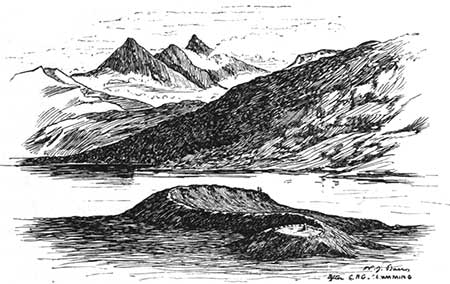 |
| The Serpent of Loch Nell. (Reproduced by Permission of Isbister ∓ Co., Limited, London.) |
General Forlong, in commenting on this, says:
Here, then, we have an earth-formed snake, emerging in the usual manner from dark water, at the base, as it were, of a triple cone,—Scotland's Mount Hermon,—just as we so frequently meet snakes and their shrines in the East.
Is there not something more than mere coincidence in the resemblances between the Loch Nell and the Ohio serpent, to say nothing of the topography of their respective situations? Each has the head pointing west, and each terminates with a circular inclosure, containing an altar, from which, looking along the most prominent portion of the serpent, the rising sun may be seen. If the serpent of Scotland is the symbol of an ancient faith, surely that of Ohio is the same.
On a preceding page brief mention has been made of mounds and burial-places on the plateau which spreads to the southeast from the coiled tail of the serpent. It is now essential to refer to the discoveries made during the exploration of these places; where, by the aid of the pick and the spade, much of the history of the past has been revealed. Here, under a mound, there, deep down in the clay, and here, again, in the recent soil, were the several pages of the book which we must now read. The language of this book is that of stones, bones, and ashes; and it will tell us anew of the great drama of life.
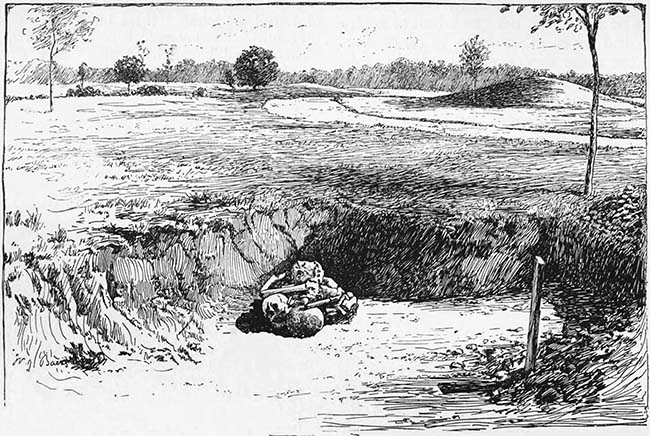 |
| Burial-place under village site, Serpent Mound Park; large conical burial-mound on right in middle distance. The stake shows position of skeleton in clay. |
It is said that fifty years ago that part of the plateau which is near the serpent was a foot or two above the level of the rest. Constant cultivation of the soil, and the washing away of the loose earth, has now reduced this portion to the common level, but it is evident from the difference in the color and character of the soil that this part of the plateau has been the dwelling-place of man. Beginning at one edge of this darker soil, it, and the clay below, for a foot in depth, was examined inch by inch, as the men worked forward in a line, throwing the earth behind them. Evidence was thus obtained of the former existence of habitations, shown by the burnt places and ash beds marking the sites of dwellings. In these ash beds and in the soil around them were thousands of chips and flakes of flint and other stones, as well as rough pieces of jasper, quartz, and other rocks, just as they were brought from the gravel bed of the opposite hill, or from other places, to be here worked into implements of various kinds. About the old hearths, and here and there in the earth, hundreds of finished implements were found— hammers which were simple nodules or pebbles of hard stone with abraded edges, or pebbles with pits pecked upon the sides; chisel-shaped implements with a sharp-cutting edge; axes of various sizes; knives of many shapes, some made of long flakes of flint or chalcedony and others beautifully chipped from various kinds of stone, some long and slender and others like long spear-points, which, in fact, they may have been; chipped drills and perforators; and many small chipped points of different sizes and shapes, some of which were arrow-heads and others the blades of knives or dagger-like implements. Several ornaments made of stone were also found, and in the ashes were bones of deer and of birds, which had been sharpened to a point. Everywhere were pieces of rude pottery, the fragments of cooking and other domestic utensils. In the ash beds were also many bones of fish, turtles, birds, and mammals, the remains of animals used for food. All these things showed beyond question that here had been an ancient village; and although the land had long been subjected to the white man's plow, so that everything near the surface had been thrown out of place, it was still evident that the ash beds and objects found on and in the clay, below the twelve to fifteen inches of dark soil, were older than those near the surface. As our explorations were continued we discovered that here had been dwellings and burials of different times. Some of the graves were only deep enough to reach the clay, while others were in the clay;. and over one, at least, a small mound had been raised, of which the plow had left only the base undisturbed.11 In one place a grave had been made to a slight depth below the soil, and here had been placed portions of the skeletons of three persons. The skulls, with a large part of the long bones and some of the smaller bones of the three skeletons, had apparently been brought to the spot in a bundle and placed in this grave. These bones, while evidently of considerable antiquity, were far more recent than several other extended skeletons near them in the clay. Does not this burial of bones show that the spot was revered, either as the home of ancestors, or from its vicinity to the sacred shrine, about which traditions may well have been preserved long after the immediate descendants of its builders had disappeared from the region? Not far from this pile of bones was a grave near the surface, about which stones had been placed on edge. This was in every way like the unquestionably recent Indian graves on the surrounding hills, which are referred to in the note below.12 This grave was so near the surface that the side stones had been thrown down by the plow, which had made one furrow directly through the skeleton. On the ribs of this skeleton was the shell of a box-turtle, and, near by, a bone from the foot of a deer. The grave had been made, all unwittingly, partly over an ancient grave of particular interest. This older grave had been made about five feet deep in the clay, and was about nine feet long and five wide. A pavement of flat stones was placed over the bottom, and on them, at the south side, compressed into a mass of ashes and charcoal not over an inch in thickness, were the fragments of a skeleton. The pieces of skull found at the southeastern corner of the grave were twice the usual thickness. Over these remains were ninety-six large stones, brought from the creek; and on these stones were found portions of another skeleton. In this instance the body was extended along the eastern edge of the grave, with the head to the southwest. Several stones were found over these fragments of bones, and four inches above the stone covering the skull was the bottom of the central portion of the most recent grave, in which the body had been placed with the head to the east. I mention these positions to show that there was no uniformity as to the position in which the bodies were placed. This was the case with all the burials about here. It may be that some peoples and tribes have particular customs in regard to this point, but our explorations have shown that no uniform rule was followed, in ancient times, in many parts of America.13
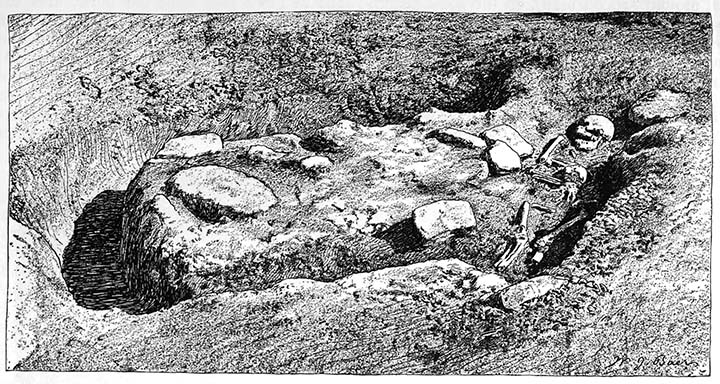 |
| Recent Indian grave, showing position of burial over an ancient grave marked by the stones. |
Pages could be filled with instructive details relating to this burial-place and village site, with its fireplaces and graves, and little refuse piles containing animal bones and various objects upon the clay; showing that at one time either the dark soil had been cleared away and fires built upon the clay, or, as I consider by far the more probable, only a few inches of soil had formed at that period.
We must now turn our attention to the conical mound (26 on map), on the southeastern portion of the plateau, which is shown in a preceding illustration. This proved to be a monument over the body of a man who was buried in connection with important ceremonies.
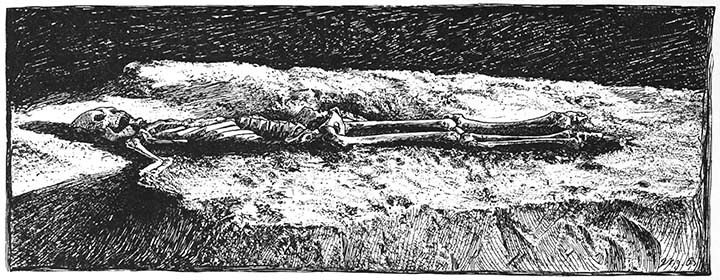 |
| Skeleton on ash bed at bottom of conical mound. |
First an area seventy by seventy-one feet in diameter was cleared of all the dark soil, and the clay was also removed for several inches in depth, making a clear, level floor. Eleven feet northwest of the center a trench was dug, 14 inches deep, 2 feet wide, and 5 feet long, and again filled with loose clay, in which were a few small stones and several broken bones of animals. On the south side, from 6 to 11 feet from the center, and from 1 to 5 feet apart, were four small holes in the clay, and 14 inches southeast of the center was another. Each contained stones or a few animal bones or ashes. On the north side, from two to six feet from the center, were four more of these holes, in which were small stones and animal bones. These holes varied from a few inches to over a foot in depth, and from two feet to nearly seven feet in diameter. Their position, and the fact that they each contained something intentionally placed in them, shows that they were made for a purpose. It was evident from their character that they were not places where posts had stood, forming part of a wooden structure.14 Over this cleared area, and of course covering all these holes and the trench, clay was placed, forming a level platform eighteen inches high. In the central portion of this platform, covering a space thirty by thirty-five feet in diameter, a fire had been kindled and kept burning until a bed of ashes a few inches in thickness was made, to which may have been added ashes brought from other places, perhaps in great part from the burnt area extending for nearly one hundred feet north of the mound as indicated by the dotted lines at 25 on the map. In this ash bed were found many small bits of pottery, pieces of burnt bone, and many stone chips; several broken stone implements and about a dozen perfect ones; also pieces of the shells of fresh-water clams; all of which is suggestive of scraping up ashes from various hearths and depositing all upon the heap. That a large part of the ashes was made on the spot was evident from the burnt clay below, and from the several continuous masses of charcoal, the remains of logs from two to four inches in diameter. When this ceremony was finished and enough ashes for the desired purpose had been obtained, the body of an adult man, nearly six feet tall, was placed, with the head to the east, at full length upon the hot ashes, and at once covered with clay, smothering the still smoldering logs and changing the embers to charcoal. Objects of a lasting nature do not seem to have been placed with the body, unless some of the chipped flint points found near it in the ashes may be so considered. It may be asked if this was not an unsuccessful case of cremation, but I think that question may be answered in the negative; for while cremation was often practiced, as I have found on other occasions, it was by different methods, and the ashes and calcined bones were afterwards gathered up for burial, or buried in a peculiar manner at the place of burning.
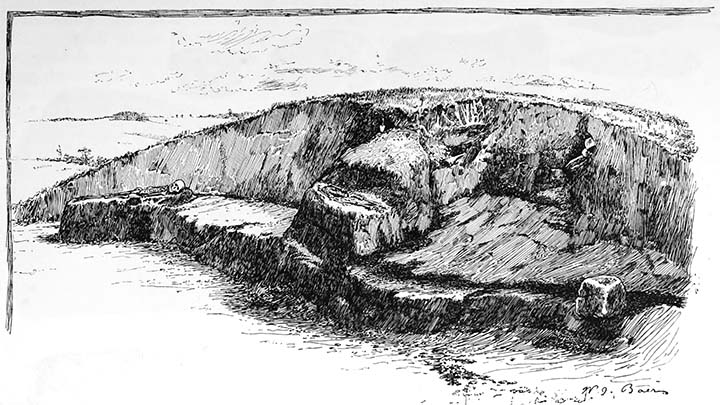 |
| Section of conical mound, showing intrusive burials. |
Several peculiarities of this skeleton are worthy of notice. It was that of a well-developed man of ordinary size. The skull was crushed by the weight of the earth above, as shown in the photograph here reproduced. While this man was fully grown and probably about twenty-five or thirty years of age, he never had any wisdom teeth, and a search in the maxillary bone of one side showed that there was no wisdom tooth forming in the jaw.15 With this exception he had a fine set of teeth, and still embedded in the premaxillary bone is a partly formed left incisor tooth. No corresponding formation can be seen on the opposite side of the suture, and this is probably a supernumerary tooth, although the small size of the lateral incisors is suggestive of their being persistent first teeth. As is often the case in skulls of this race, the crowns of the incisors are distinctly folded. All the sutures of this brachycephalic skull are unusually open and denticulated. Along the suture uniting the occipital bone with the posterior part of the two parietal bones there are several intercalated pieces, or "Wormian bones." Such bones are more common in the American brachycephalic skulls than in the dolichocephalic, and in this skull they are so numerous as to cause the division of the upper portion of the occipital bone into several small pieces.16 At the time of birth the frontal bone in man is still in two pieces, which gradually close by a central suture. Normally this frontal suture is obliterated in a few years and the frontal becomes a single bone. Occasionally this suture persists through life, and such crania are called metopic. This occurs more often in the white race than in any other, and seldom in the lower races. It is therefore of interest to note the existence of this anatomical feature in an individual at whose burial so considerable a ceremony took place, and over whose body such an imposing monument was erected.
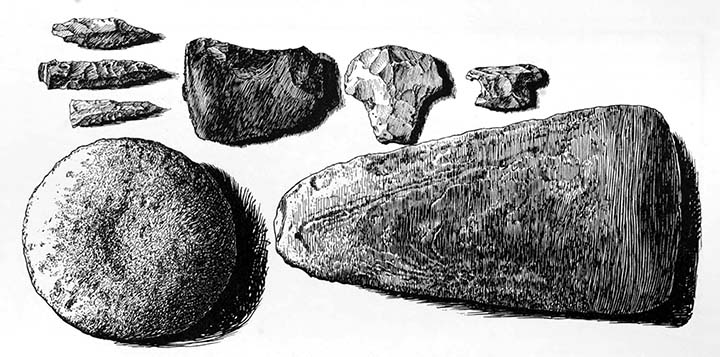 |
| Stone implements (half size), from different parts of conical mound. (Now in the Peabody Museum.) |
After the immediate covering of the body with clay, the mound was raised, a symmetrical conical heap of clay, to the height of ten or twelve feet.17 Some time subsequent to the building of the mound, and after the clay had settled into a compact mass, graves were dug upon its sides and top, and nine burials had taken place. Some of the intrusive graves were so near the surface that in plowing over the mound the bones had been disturbed, while others were much deeper. One skeleton was found on the eastern side of the mound, and four feet from the exterior. As shown in the illustration, the skeleton was extended at full length nearly north and south. At a little greater depth from the top of the mound another skeleton was found, extended nearly east and west. Woodchucks had made their burrows in this part of the mound and had thrown out portions of the skull and other parts of this skeleton, among the bones of which they had made their nest. The stones seen in the illustration, near the surface of the mound, mark another grave over which the four stones had been placed. The bones in this and in the six other graves near the surface of the mound, were much decayed, and only fragments of the skeletons could be traced. In one instance only was anything found with the skeleton, and that was a fine stone hatchet resting, with its edge outward, on the bones of the left forearm, as if the handle had been placed along the arm and held in the hand. This implement is shown, with others from the mound, in the illustration above, all of which are represented of half size.
During the exploration of the mound a number of stone implements were found, principally near the bottom on a level with the ash bed, but several chipped points, or "arrowheads," were also discovered at various depths in the clay, as if they had been lost during the erection of the mound. Among the objects of special interest found in or near the ash bed, and thus associated with the first burial, were a hemisphere of hematite, a plummet-shaped implement, a small hatchet, and several perfect points chipped from flint. Two finely finished and polished stone axes with straight backs, and grooves around them for holding the withes by which they were fastened to handles, were also found at the bottom of the mound. A few points made of splinters of bone were found in the ashes; and near the edge of the ashes, but not in it, was a plate of copper, slightly irregular in outline, nine and a half inches long, three and a half to four inches wide, and one-eighth to nearly one-quarter of an inch thick, unquestionably hammered out of a mass of native copper.18
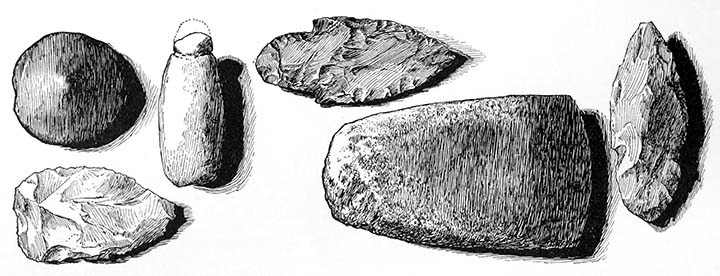 |
| Hematite hemisphere, grooved stone implement, hatchet, and flint knives (half size), found on or near ash bed in conical mound. (Now in the Peabody Museum.) |
At the southwestern portion of the plateau, on a knoll now shaded by a wild cherry tree, and to which reference has previously been made (32 of map), there is now a small low mound which has recently been restored, having been nearly plowed down years ago. Its site was noticed by Dr. Metz while examining the plateau with me, three years ago. The year following I explored the place and here found the first burials, which have an antiquity as great as that of the serpent itself, and we have every reason to believe that the bodies buried at this spot were of the people who worshiped at the serpent shrine.
 |
| Copperplate and stone axes (half size), from bottom of conical mound. (Now in the Peabody Museum.) |
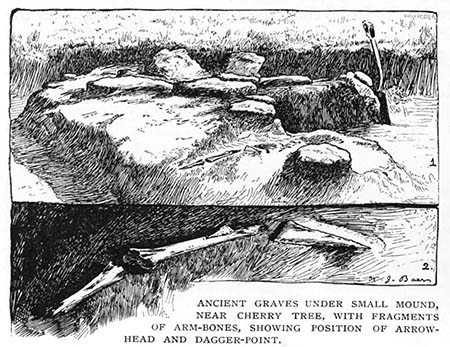 |
| 1, Position of stones covering ash bed and graves in mound. 2, Enlarged drawing of arrow-point on upper part of right arm and dagger-point on right chest; original objects now in Peabody Museum. |
 |
| Chisel-like implement made of antler (little less than half size) from grave. (Now in peabody museum.) |
The second fireplace was four feet southwest of the first, and was made of much larger stones, ten in number, which rested directly upon the boulders, from among which the stones had evidently been taken. There was no regularity in their arrangement, and the fire had been built upon them. Among them a small amount of charcoal, made by burning twigs and grass, was scraped up, but the place had evidently been carefully cleared of its ashes.
About four feet north of the west end of this fireplace was the first grave, which was nearly three feet deep, and had been dug down to the boulders, between which a few stones had been placed to make an even bottom, upon which the body had been extended at full length, with the head at the eastern end of the grave. The bones were much decayed, and the portions preserved were deeply stained with iron. The skull was crushed, but so firmly impacted in clay that nearly all of it was secured in small pieces. There were neither ashes nor implements nor objects of any kind in the grave.
Sixteen feet westward was a grave which proved to be of great interest. The twenty to thirty stones marking this grave were removed, and two feet below them, covered with clay, were two masses of burnt bones, ashes, charcoal, pieces of many points made from the leg-bones of deer, a chisel-shaped implement made of antler, and pieces of others, a number of chipped flint implements in various forms of knives, long points, and arrow-heads. One of the masses of burnt material was near the center of the grave and the other was at the southern end. Under them were two skeletons extended at full length side by side, with the shoulders against the hard clay at the northeastern edge of the grave. Remains of the clavicles and of the scapula bones were in place, but not a trace of the upper cervical vertebrae or of the skulls could be found, although for hours a careful search was made in all parts of the grave, and for two feet beyond all signs of former disturbance of the clay; and it was evident beyond all question that these two bodies had been decapitated before they were placed in the grave. These skeletons were lying in the clay eight inches above the boulders. The portions of the bones remaining, while thoroughly impregnated with iron, were much decayed, and only the more solid portions of the arm and leg bones held together, though the outlines or casts of nearly all the bones could be traced in the clay as it was carefully removed.
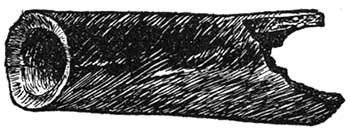 |
| Tube or handle (little less than half size) made from legbone of a deer from ashes in cremation place. (Now in Peabody Museum.) |
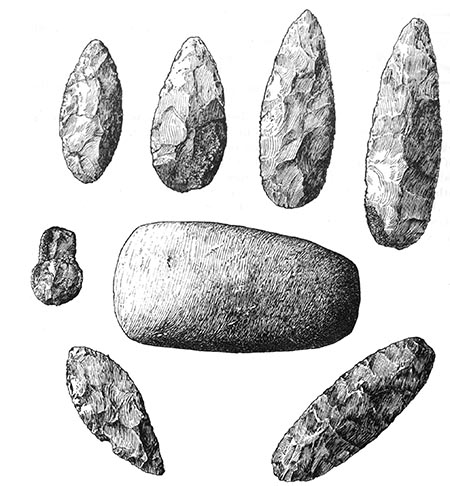 |
| Stone hatchet and knives of flint (less than half size) found near left knee of skeleton. (Now in the Peabody Museum.) |
The burnt material in this grave is of the same character as that found on the first fireplace, and among the burnt bones are many fragments which can be identified as human. Not only this, but there was also found in the grave another piece of the implement made of antler. This has a jagged edge exactly fitting the corresponding edge of the piece from the fireplace, and it cannot be questioned that they originally formed a single piece of a chisel-like implement. We therefore have reason to believe that at the time when the two headless bodies were buried the body of another person was burnt near by, and that the ashes containing the burnt bones, and various objects burnt with the body, were placed over the two individuals in the grave, partly over the legs and feet of one skeleton and partly over the right hip and leg of the other skeleton. Besides the fragment of the implement which matches the other piece from the fireplace, the burnt mass in the grave contained a piece of a sharpening stone, forty flint flakes and chipped pieces of stone, eighteen chipped implements of various kinds, several of which were splintered by the heat, a number of pieces of implements made of deer antler, the bones of animals, and four natural pieces of lead ore (galena). Resting on the burnt mass, but evidently put in afterwards, was a little red ocher in which was a much decayed point made from the metacarpal bone of a deer; and near by were the remains of several other bone implements of the same character, and a chisel-like implement made of antler. In the clay filling the grave above the ashes were two chipped implements of flint.
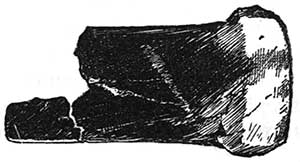 |
| Implement made of antler (little less than half size) from grave; the small piece from the ashes of cremation place. (Now in Peabody Museum.) |
Six feet farther to the west stones were scattered here and there on the surface of the clay, over an area of about four by eight feet, partly covering three closely adjoining graves, all of which had been dug down to the large boulders, a depth of three feet. At the bottom of one of these graves were several large flat stones resting on the boulders. The body had then been placed at full length in the grave, with the head at the eastern end; ashes containing considerable charcoal had been placed over the body, and over this about a foot of clay. The grave was then filled with stones, some measuring a foot or more in diameter, but the greater part much smaller. Two rows of stones, about seven feet long and two feet apart, marked the grave on the surface. There was nothing in the grave except the bones of the skeleton, very much decayed, the fragments of which were impregnated with iron. A stone had been placed over the head, which, while it had crushed the skull into many pieces, had so protected the cranial bones that they had become thoroughly charged with iron and were thus preserved.
Adjoining this grave, to the south, was another, the bottom of which was clay, resting on the boulders. In this instance the body had been covered with clay. The enamel of a full set of teeth lay in the clay in their natural position, even to the wisdom teeth of the upper jaw, which were slightly above the line of the others, showing that they were just cutting through the bone at the time of death. The outline of the skull and of many of the bones of the skeleton could be traced in the clay, but only as minute particles of bone, the cells of which were filled with iron. Nothing more was found in this very ancient grave.
West of this, and at the same depth, was another grave, about four feet long, in which were found only iron-stained fragments of a tibia and fibula and several of the bones of a foot. No other fragment of the skeleton could be discovered, not even bone particles in the clay; but just beyond these fragments was a mass of light gray ashes containing many small pieces of calcined bones, which proved to be human by the identification of the crown of one molar tooth, a small piece of occipital bone, and two small pieces of the under jaw. With these burnt remains were a few flint chips and small flakes, but nothing more. The surface stones did not cover the extreme western point, thirty-eight feet from the first fireplace, where these ashes were buried.
There is still much to be done in exploring other spots in the immediate vicinity of the serpent before we shall know all that the earth has hidden of the past relating to this old monument. But the outlines of a picture have been traced out, which can be filled in as individual fancy may dictate, or as discoveries here and elsewhere may determine. It is evident that written history will be of little aid, although the customs of some of the many tribes or peoples who have passed to and fro over the land may give us a hint, here and there, to the better understanding of some things which have been revealed. History, however, has its limits, and any attempt to make it apply to a time anterior to those limits, and from vague general resemblances to draw conclusions, is unwarranted. Let the archaeologist work on with greater care than ever before. Let him, if possible, start with the earliest traces of man, and, step by step, follow his record in the past down to the dawn of history, when language, myths, and legends open the door to the historian, who then takes the place of the archaeologist.
To work in the other direction, with the idea that language and history can tell us of the relations of mankind in early times, is starting with the assumption that man has everywhere, and in all past times, been as now; that there has been no development within a race, no diversity of races, no migrations of peoples, except in recent times, and no change in the innumerable languages now spoken. The origin of any one of these languages is not as yet actually known and probably never can be known, from the fact that archaeology leads us to believe that man existed so long ago that the thousands of years since man in America hunted at the foot of the glaciers are but as yesterday compared with his probable but still unknown origin. What languages were spoken throughout all this time? We only know that the skulls of earliest man yet discovered are as perfectly those of man as are our own, and of man with a brain capacity and muscular and bony structure indicating powers equal to those of races existing to-day. Some races have developed these powers more rapidly than others. Who is yet able to state where man originated? and who but the archaeologist, with the aid of the geologist, can take up the snarled skein with any hope of unraveling the great mystery of man's origin?
What light is thrown back over one brief period of the past by this study of the Serpent Mound and its surroundings, this singular structure in the midst of many other strange earthworks in the Ohio Valley! If history can now lend its aid and bring out some points with clearness, much will be gained. But it must be critical and trustworthy history, and not the simple patchwork of vague generalities.
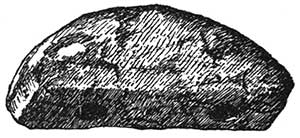 |
| Ornament cut from crystal of galena found in grave. (Now in the Peabody Museum.) |
Now another race has come, and the old shrine, cleared of rubbish, is again held sacred; not for ancient and awful rites, but for the study of future generations, when a wider knowledge of the past in other countries shall lead to a better knowledge of that of our own.
Footnotes
1 See also an article in the last number by the same author.2 With the hope that similar laws will be passed in other States in which are archaeologic monuments that should be preserved, the Ohio law, which was passed March 27, 1888, is here given as one well worthy of imitation.
AN ACT
SECTION I. Be it enacted by the General Assembly of the State of Ohio, That all lands in the State of Ohio on which are situate any prehistoric earthworks, and which have been or may hereafter be purchased by any person, association, or company for the purpose of the preservation of said earthworks, and are not held for profit, but are or shall be dedicated to public uses as prehistoric parks, shall be exempt from taxation.
SECT. 2. The owners of such prehistoric parks may establish all reasonable rules governing access to said parks; and any person willfully violating such rules or injuring said works, or any structure, trees, or plants in said parks, shall be fined in any sum not exceeding fifty dollars, or imprisoned not exceeding sixty days, or both, and shall also be liable to the owners of said parks in a civil action for all damages caused by such person.
SECT. 3. This act shall take effect and be in force from and after its passage.
3 Near the close of the session Congress passed an act for the preservation of the ruin everywhere known as the Casa Grande, and this was brought about by the special interest taken by Mrs. Mary Hemenway of Boston, who for several years past has been deeply interested in, and a most generous supporter of, archaeological work in America.
4 The great Cahokia Mound in southern Illinois, the largest mound in the United States, should at once be protected by the State of Illinois, as it already has had a narrow escape from being used for ballast on a railway.
5 While provision is thus made for the comfort of transient visitors and picnic parties from the neighboring towns, it is important to add, for the information of visitors from a distance, that accommodations can be had at some of the farmhouses in the vicinity. It is probable that the increasing number of visitors will soon lead to building a summer hotel on the adjoining farm. The fact that over three thousand persons visited the park last summer is evidence of the need of such a house. The park can be reached by the following routes: Starting from Columbus, early in the morning, over the Scioto Valley Railroad, and changing cars at the Portsmouth junction with the Ohio and Northwestern Railroad for Peebles, reaching there about noon, where a suitable conveyance can be had for a drive of seven miles to the park. Or, leaving Columbus in the afternoon, by the Midland Railway, for Blanchester, changing cars there for Hillsborough, and then driving from Hillsborough to the park, about eighteen miles, over a fine pike. From Cincinnati morning trains over both roads run through to Hillsborough and Peebles, and the park can be easily reached in the afternoon by either route.
6 Forlong, in his carefully elaborated volumes and wonderful compendium of facts relating to the faiths of man,* shows the existence of serpent worship in India and Africa to this day; and the survival, in part, of its symbols, together with those of other primitive religious faiths. Fergusson, in his critical and widely known volume,† also states that serpent worship still holds an important place in the religion of India. He also speaks of its great development in Cambodia, at the time when the country was conquered by the Siamese in the last half of the fourteenth century, and Buddhism superseded serpent worship. Fergusson thinks this latter faith was there introduced in the fourth century, and resulted "in some of the most wonderful temples which the world ever saw, and in the most remarkable development of pure serpent worship anywhere to be found." The greatest of these temples, discovered in the jungle only thirty years ago, is that of Nakhon Vat, which is "600 feet square at the base, and rises to a height of 180 feet in the center, of which every part is covered with carvings in stone, generally beautiful in design, and always admirably adapted to their situation, and to tell the story they were meant to convey. . . . Every angle of every roof is adorned with a grim seven-headed serpent with a magnificent crest of what is apparently intended for feathers, and every cornice of every entablature is adorned with a continuous row of these seven-headed deities, but without crests. The former may be counted by hundreds, the latter by thousands. But it is not only there; every balustrade, every ridge, almost every feature of the building, bears the same impress."
* "Rivers of Life; or, Sources and Streams of the Faiths of Man in all Lands; showing the Evolutions of Faiths, from the Rudest Symbolisms to the Later Spiritual Developments." By Major General J. S. R. Forlong. London, 1883. 2 vols. 4to, and chart.
† "Tree and Serpent Worship; or, Illustrations of Mythology and Art in India in the First and Fourth Centuries after Christ," etc. 2d edition. London, 1873. 1 vol. 4to, with many photographic illustrations.
7 Forlong quotes, Vol. I., p. 287: " Mauretania had mighty dragon temples, avenues, and 'fields' of this faith 'over whose backs' grass was most abundant. Taxiles showed Alexander 'a serpent of five acres' in the Punjab. Strabo describes two somewhat similar ones, and Posidonius saw one in the plains of Macra, in Syria, such 'that two persons on horseback, when they rode on opposite sides, could not see one another; each scale was as big as a shield.'"
8 Forlong, on p. 255, refers to this: "As usual, we must carefully study the topography of the shrine; for it is always this, and not signs or miracles, from or by the gods, which first attracts wise priests. Fitting scenic effect is necessary towards the success of every drama we intend to place before the public, more especially if we wish to inspire an enduring reverence, awe, and worship, with tragic interludes."
9 In regard to this, Forlong, referring to the Ohio serpent, p. 290, writes: "A spot overlooking three streams being even more sacred than that which looks on to a hill with three cones, as does the serpent of Loch Nell. Three rivers form a Tri-Moorti of 'awful and sublime import.'"
10 Professor Stuart Blackie, in "Good Words," March, 1872.
11 An elderly gentleman has informed me that he remembers noticing in his youth many small mounds in the woods then covering this spot.
12 A hundred years ago there were several settlements of Indians in this part of Ohio, and so recently as the year 1800, and for several years after, a small band of Indians were living on the bottom-land near the forks of the river on the opposite side, and not far from the serpent cliff. The sites of the wigwams were pointed out to me by Mr. Hewes, whose grandfather settled on the place and had much to do with the Indians who were living there. On many of the hilltops about the valley I have seen groups of the graves of these recent Indians. The graves are only a foot or two in depth, and wide and long enough for the body to be placed, at full length, between rough stones set on edge around the body and projecting above the ground. Occasionally these graves are covered with flat stones. So far as my experience goes, very few objects are found with the skeletons in such graves.
These recent graves, found in Kentucky, Ohio, and to the westward, have often been described and discussed as having the same character as the carefully constructed stone graves of the Cumberland Valley in Tennessee. But there is in reality only a very general resemblance between them, and neither by their structure nor by their contents do they indicate one and the same people, but on the contrary they show marked differences; and the great antiquity of the Tennessee stone graves as a whole is in marked contrast with these recent graves on the hills along Brush Creek Valley. On the points of the hills are also many stone mounds, with an occasional earth mound, which are monuments over graves of far more recent times than the building of the serpent and other great earth structures of the Ohio Valley.
13 I have recently explored a burial-place of the Massachusetts Indians at Winthrop, near Boston. Of eight skeletons found here all had their heads to the south, and of five adults and one child all but one faced the east, one adult facing the west. Two infants were in the same grave, resting upon their backs, between the skeletons of a man and a woman, placed on their sides, facing the east.
14 Post-holes, regularly placed, are often found under burial-mounds, but any one familiar with such holes would not mistake these strange little pits for them.
15 The late development of the third molars, or " wisdom teeth," in the ancient brachycephalic skulls of Ohio seems to be a decidedly marked characteristic of this people, and in this instance there was none forming. It has been remarked that among the Hindus a large proportion never have wisdom teeth.
16 The frequent occurrence of these subdivisions of the occipital bone in the short-headed race of the south is a marked characteristic of the race. It was long ago pointed out that in the skulls of the ancient Peruvians (short-heads) there was often a suture across the upper portion of the occipital bone, thus leaving a triangular bone between the parietals, to which the name "Inca bone" was given. The large number of skulls of brachycephalic Americans now brought together in the Peabody Museum shows that this tendency to subdivision of the occipital is common to the race, and occurs in the short skulls from Ohio as well as in those of Peru and all the intermediate regions.
17 Previously to the time of my first visit the mound had been plowed and cultivated for several years, thus reducing its highest point to nine feet, to which height I restored the mound after the exploration.
18 Similar plates, but having two holes, probably for suspending them from the neck, have been found in other mounds and with skeletons. In one case we found such a plate lying upon the breast-bone of a skeleton in a mound in the Scioto Valley. In several instances we have found them covered on one side with cloth, which was preserved by the copper salts, thus enabling us to study the method of weaving the cloth made from twisted vegetable fiber. One of these plates is figured in the "Eighteenth Report " of the Peabody Museum, Cambridge, 1886. On this plate a lock of hair has been preserved by the copper. I have recently seen a remarkable instance of the preservation of tissues by the salts of copper, in the skull of a Massachusetts Indian, found at Winthrop, and given to the Museum by Mr. Charles A. Hammond of Lynn. This Indian had been buried with a broad thin plate of copper fastened as an ornament over the forehead. Over this had been placed a piece of woven native cloth, over which at the time of burial a mat of braided cedar bark had been laid. The action of the copper, which was very much oxidized and decomposed, had preserved portions of each of these fabrics, as well as the hair and scalp on one side of the head, and the skin of a large part of the face. The bones below, even including half of the under jaw, were colored green by the carbonate of copper that had penetrated through the cells to the inner table of the skull, which was also colored green; and portions of the brain, or at least its surrounding tissues, now exist as a hard dark mass in the cavity of the skull. We have historical evidence that this Indian must have been buried as early as 1650; but probably it was before that time, and in its present condition there is every reason to believe that the skull would have lasted for centuries to come.
19 That the skulls of individuals were considered important objects, perhaps trophies, as with the Dyaks, is evident from a singular burial which we discovered in a mound in the Little Miami Valley, where the skeleton of a man and that of a woman were found buried at full length in ashes, and surrounded by sixteen skulls, which showed by the scratches upon them that the flesh had been removed by scraping. Six of these skulls had small holes bored in them as if for the purpose of decoration, and at least two of them had also been partly painted red.
